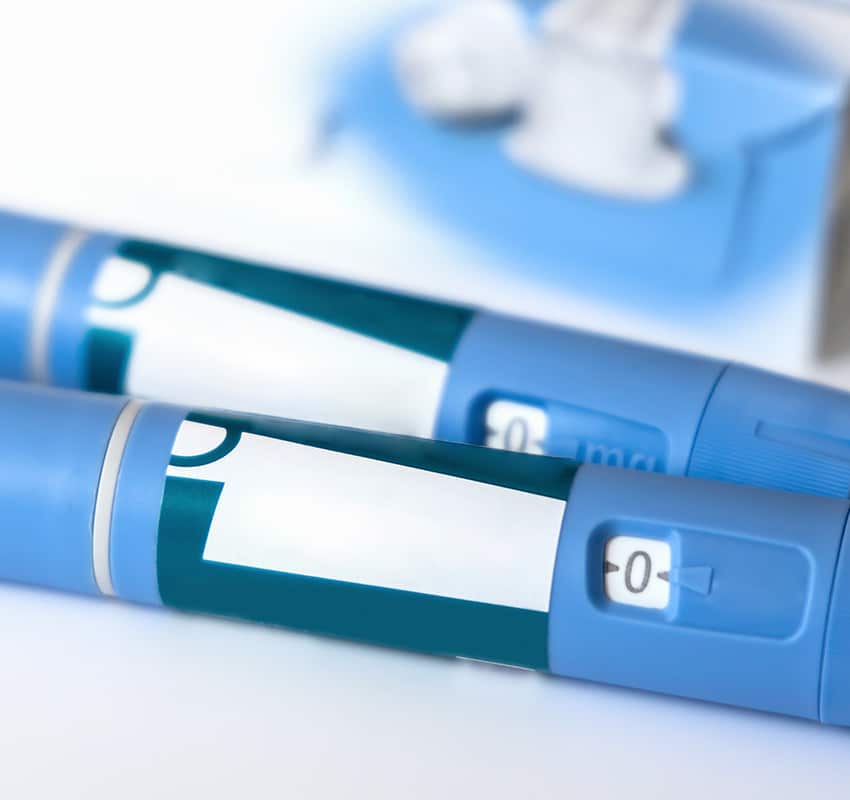GLP-1 Targeting Solutions
With diabetes becoming more prevalent across the world, scientists are constantly searching for new ways to treat diabetes. GLP-1 drugs are are now an important part of many treatment plans for diabetes type 2 and weight loss. Healthcare companies are investing considerably for the promotion and advertising of GLP-1 medication.
What is GLP-1
GLP-1 is a class of drugs that is used for controlling blood sugar levels and weight of type 2 diabetic patients. These types of drugs are usually referred to as glucagon-like peptide 1 (GLP-1). Glucagon-like peptide-1, or GLP-1s, are receptor agonists that mimic the actions of the GLP-1 hormone by stimulating GLP-1 receptors in the pancreas and increasing the body’s production of insulin. In order to help manage Type 2 diabetes, insulin lowers blood sugar levels. GLP-1s have also been shown to aid in weight loss since they prolong feelings of fullness in those who take them.
How does GLP-1 work
These medications cause the body to create more insulin when blood sugar levels begin to increase after eating. The additional insulin aids in lowering blood sugar. Reducing blood sugar levels can help manage type 2 diabetes. However, it’s unclear how using GLP-1 medications causes weight reduction. Physicians are aware that GLP-1s seem to reduce appetite. Moreover, the passage of food from the stomach into the small intestine is slowed by these medications. You can feel fuller for longer as a consequence, which makes you eat less.
Apart from aiding in blood sugar regulation and promoting weight reduction, GLP-1s and SGLT-2 inhibitors appear to offer other significant advantages. Certain medications in these categories have been linked to a decreased risk of heart-related conditions, including heart failure, stroke, and renal disease. Individuals using these medications have reported improvements in their cholesterol and blood pressure. However, it’s unclear if the medicine or the weight loss is responsible for these advantages.
GLP-1 Agonists
Exenatide (Byetta, Bydureon): Available as a twice-daily injection (Byetta) or a once-weekly injection (Bydureon).
Liraglutide (Victoza, Saxenda): Saxenda is used for weight management but has the same active ingredient as Victoza, which is used once daily for diabetes.
Dulaglutide (Trulicity): A once-weekly injectable medication.
Semaglutide (Ozempic, Rybelsus): Available as a once-weekly injection (Ozempic) or a daily oral tablet (Rybelsus).
Albiglutide (Tanzeum): Was available as a once-weekly injection, but it has been discontinued in the market.
Lixisenatide (Adlyxin): Administered as a once-daily injection.
Semaglutide (Wegovy): Similar to Ozempic, it’s used for chronic weight management.
Exenatide extended-release (Bydureon BCise): A newer formulation for once-weekly injection.
Tirzepatide (Mounjaro): A novel dual GIP and GLP-1 receptor agonist, approved for use in the United States in 2022.
Diabetes Targeting Solutions
Delivering customized advertising campaigns to audiences interested in diabetes treatment is the main goal of Diabetes Targeting Solutions. These solutions use advanced data analytics to identify and categorize populations according to how they engage with diabetes-related material. Examples of these populations include patients seeking advice on managing their condition, carers seeking assistance, and medical professionals wanting to update their expertise.
Precision advertising forms the foundation of Diabetes Targeting Solutions and Type 2 Diabetes Targeting Solutions. Through the use of search activity, prescription data, and patterns of content consumption, advertisers are able to identify the people who are most likely to interact with materials linked to diabetes. This raises the possibility that advertising funds will be used to reach a target audience and increase the chance of a campaign’s success.
Rise of GLP-1 Advertising:
Ozempic, a brand of Semaglutide, a GLP-1 receptor agonist used to treat Type 2 diabetes, recently made news due to a statewide scarcity as its usage as a weight reduction medicine gained popularity. When Wegovy, the brand of Semaglutide advertised for weight loss, became scarce, some patients were prescribed off-brand Ozempic, making the prescription even more difficult to get. Many people with Type 2 diabetes who used Ozempic to treat it are now rushing to find the drug.
We all know that people research their symptoms and medical conditions online prior to attending medical appointments. Looking for prevention, treatments, alternative therapies, medications, ways to manage symptoms and the likelihood of recurrence are just some of the frequently searched terms. This advertising is ideal for pharmaceutical companies and health-focused businesses who want to connect with individuals managing diabetes and those striving to maintain a healthy weight.
Health Targeting is in our DNA
Since 2012, we’ve been the leader in Health advertising. Healthy Ads can deliver Health Targeting across publisher content in Real Time.
Reach Patients with Diabetes or wanting to lose weight
We offer the ability to advertise on pages next to articles or blogs about GLP-1. We know that people looking at content related to GLP-1 either suspect or have Type 2 Diabetes or want to control their weight and are researching if this could be a suitable medication for them. They are also probably about to go out to discuss their symptoms with their doctor and be provided a treatment plan and are likely to discuss what they have researched online. This is an ideal time for Direct-to-Consumer Advertising (DTC) for GLP-1 medications.
GLP-1 Targeting Solutions
Realtime GLP-1 Targeting
Our Realtime GLP-1 Targeting option allows an advertiser to run their advertising next to GLP-1 content webpages as the researcher looks at the page. This is the ultimate solution for advertising GLP-1 treatment options or preventions. We can run this type of contextual targeting across our own Managed Supply, our Curated Supply and via a Media Plan via Managed Services.
Popular GLP-1 Searches
There is a significant number of GLP-1 searches each month. The top twenty searches we see related to GLP-1 include;
- GLP-1 receptor agonists
- Diabetes GLP-1 treatment
- Weight loss with GLP-1
- GLP-1 and obesity
- GLP-1 medications
- GLP-1 side effects
- GLP-1 vs insulin
- GLP-1 therapy benefits
- GLP-1 injection
- GLP-1 for type 2 diabetes
- GLP-1 mechanism of action
- GLP-1 and cardiovascular health
- GLP-1 brands
- Long-acting GLP-1 agonists
- GLP-1 and diet
- GLP-1 cost comparison
- GLP-1 patient reviews
- GLP-1 clinical trials
- GLP-1 vs metformin
- GLP-1 for prediabetes
Health Targeting Categories
Discover a wide range of Health Targeting Categories based on Contextual Targeting for your next Advertising Campaign or Programmatic Deals. Explore our offerings in Medical Conditions, Healthy Lifestyle, Chronic Diseases, Infections, Sports, and General Health to reach your desired audience at scale effectively.











